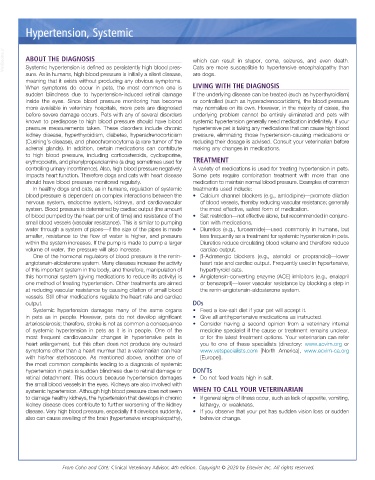Page 3032 - Cote clinical veterinary advisor dogs and cats 4th
P. 3032
Hypertension, Systemic
VetBooks.ir ABOUT THE DIAGNOSIS which can result in stupor, coma, seizures, and even death.
Cats are more susceptible to hypertensive encephalopathy than
Systemic hypertension is defined as persistently high blood pres-
sure. As in humans, high blood pressure is initially a silent disease, are dogs.
meaning that it exists without producing any obvious symptoms.
When symptoms do occur in pets, the most common one is LIVING WITH THE DIAGNOSIS
sudden blindness due to hypertension-induced retinal damage If the underlying disease can be treated (such as hyperthyroidism)
inside the eyes. Since blood pressure monitoring has become or controlled (such as hyperadrenocorticism), the blood pressure
more available in veterinary hospitals, more pets are diagnosed may normalize on its own. However, in the majority of cases, the
before severe damage occurs. Pets with any of several disorders underlying problem cannot be entirely eliminated and pets with
known to predispose to high blood pressure should have blood systemic hypertension generally need medication indefinitely. If your
pressure measurements taken. These disorders include chronic hypertensive pet is taking any medications that can cause high blood
kidney disease, hyperthyroidism, diabetes, hyperadrenocorticism pressure, eliminating those hypertension-causing medications or
(Cushing’s disease), and pheochromocytoma (a rare tumor of the reducing their dosage is advised. Consult your veterinarian before
adrenal glands). In addition, certain medications can contribute making any changes in medications.
to high blood pressure, including corticosteroids, cyclosporine,
erythropoietin, and phenylpropanolamine (a drug sometimes used for TREATMENT
controlling urinary incontinence). Also, high blood pressure negatively A variety of medications is used for treating hypertension in pets.
impacts heart function. Therefore dogs and cats with heart disease Some pets require combination treatment with more than one
should have blood pressure monitored regularly. medication to maintain normal blood pressure. Examples of common
In healthy dogs and cats, as in humans, regulation of systemic treatments used include:
blood pressure is dependent on complex interactions between the • Calcium channel blockers (e.g., amlodipine)—promote dilation
nervous system, endocrine system, kidneys, and cardiovascular of blood vessels, thereby reducing vascular resistance; generally
system. Blood pressure is determined by cardiac output (the amount the most effective, safest form of medication.
of blood pumped by the heart per unit of time) and resistance of the • Salt restriction—not effective alone, but recommended in conjunc-
small blood vessels (vascular resistance). This is similar to pumping tion with medications.
water through a system of pipes—if the size of the pipes is made • Diuretics (e.g., furosemide)—used commonly in humans, but
smaller, resistance to the flow of water is higher, and pressure less frequently as a treatment for systemic hypertension in pets.
within the system increases. If the pump is made to pump a larger Diuretics reduce circulating blood volume and therefore reduce
volume of water, the pressure will also increase. cardiac output.
One of the hormonal regulators of blood pressure is the renin- • β-Adrenergic blockers (e.g., atenolol or propranolol)—lower
angiotensin-aldosterone system. Many diseases increase the activity heart rate and cardiac output. Frequently used in hypertensive,
of this important system in the body, and therefore, manipulation of hyperthyroid cats.
this hormonal system (giving medications to reduce its activity) is • Angiotensin-converting enzyme (ACE) inhibitors (e.g., enalapril
one method of treating hypertension. Other treatments are aimed or benazepril)—lower vascular resistance by blocking a step in
at reducing vascular resistance by causing dilation of small blood the renin-angiotensin-aldosterone system.
vessels. Still other medications regulate the heart rate and cardiac
output. DOs
Systemic hypertension damages many of the same organs • Feed a low-salt diet if your pet will accept it.
in pets as in people. However, pets do not develop significant • Give all antihypertensive medications as instructed.
arteriosclerosis; therefore, stroke is not as common a consequence • Consider having a second opinion from a veterinary internal
of systemic hypertension in pets as it is in people. One of the medicine specialist if the cause or treatment remains unclear,
most frequent cardiovascular changes in hypertensive pets is or for the latest treatment options. Your veterinarian can refer
heart enlargement, but this often does not produce any outward you to one of these specialists (directory: www.acvim.org or
symptoms other than a heart murmur that a veterinarian can hear www.vetspecialists.com [North America], www.ecvim-ca.org
with his/her stethoscope. As mentioned above, another one of [Europe]).
the most common complaints leading to a diagnosis of systemic
hypertension in pets is sudden blindness due to retinal damage or DON’Ts
retinal detachment. This occurs because hypertension damages • Do not feed treats high in salt.
the small blood vessels in the eyes. Kidneys are also involved with
systemic hypertension. Although high blood pressure does not seem WHEN TO CALL YOUR VETERINARIAN
to damage healthy kidneys, the hypertension that develops in chronic • If general signs of illness occur, such as lack of appetite, vomiting,
kidney disease does contribute to further worsening of the kidney lethargy, or weakness.
disease. Very high blood pressure, especially if it develops suddenly, • If you observe that your pet has sudden vision loss or sudden
also can cause swelling of the brain (hypertensive encephalopathy), behavior change.
From Cohn and Côté: Clinical Veterinary Advisor, 4th edition. Copyright © 2020 by Elsevier Inc. All rights reserved.

